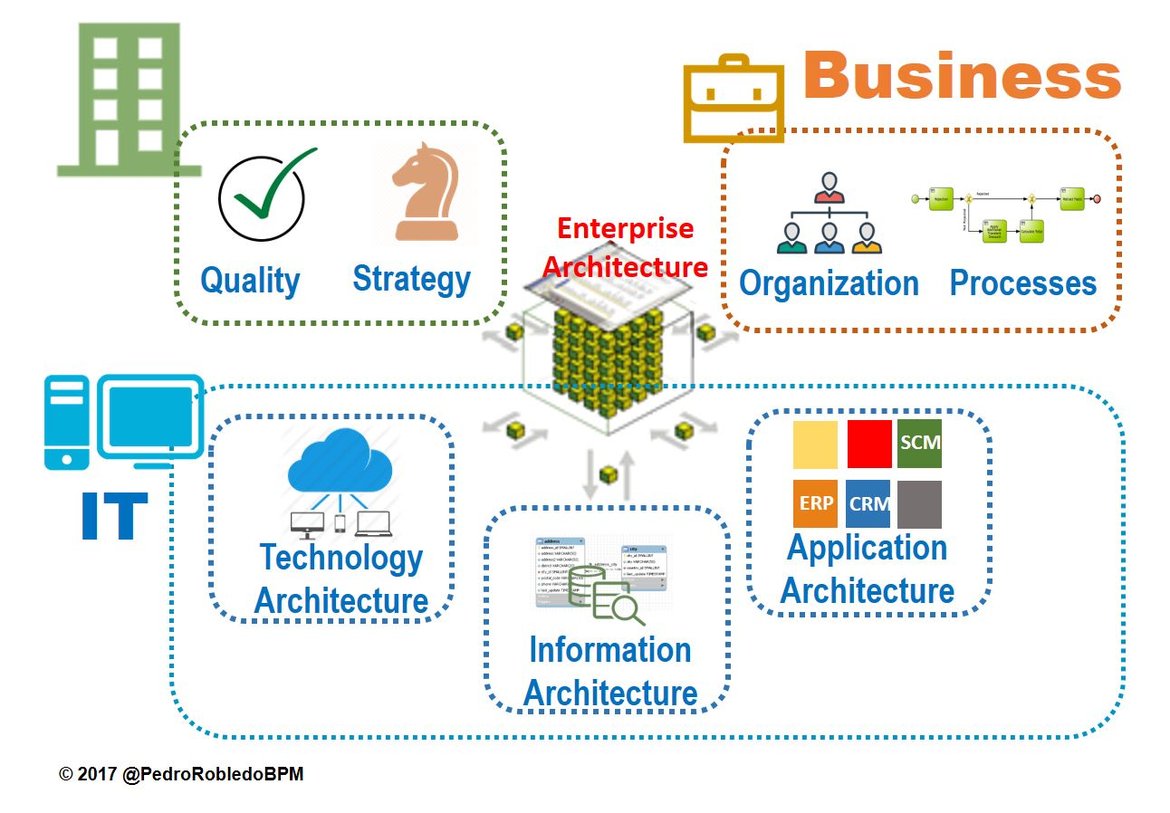¡HI! If you want to propose us a project, send a mail to info@albatian.com


ALL INFORMATION ABOUT
BPM, PROCESS, R & D, TECHNOLOGY
Any Business Innovation and Transformation requieres an Enterprise Architecture .
By: Pedro Robledo, BPM process management expert

Everyone realizes that organizations have to be innovating or continually transforming themselves to be competitive in a changing world like the present one. Both Innovation (doing something different or something new) and Transformation (making changes to something that already exists: optimizing, improving ...) will involve making changes in the organization to take it from a current state to a future state with the changes implemented. Considering that "55% of the current 500 Fortune organizations will not be in the Fortune elite in 2025" according to the OECD, "86% of executives say that innovation is extremely or very important to strategy of growth of their companies, but only 19% believe they succeed with any of the components needed" according to IBM Global, and "72% of transformation programs fail to meet their real objectives" according to McKinsey, we must wonder how to carry out this process of innovation or business transformation.
In the area of business processes, you have to consider what dimension reach the innovation or transformation project, since we can talk about Process Improvement (the process works but we want it to be more efficient, effective, more optimal ...), Process Redesign (the process is not functioning as it should, correcting it by changing the flow, eliminating parts of the process, automating parts ...), Process Reengineering (fundamental revision and radical redesign of processes for dramatic improvements in critical metrics) or Paradigm Shift to a Process Oriented Company (a change in the basic assumptions that implies a major change in the culture of the organization), and its management of change, risks and impacts in the organization should be controlled and made the right decisions so as not to fail.
If we think about our home and about a possible reform by adding a bathroom, we would have to study the viability of this project, and for it, we will have to take into account that the legislation allows us to make modifications in our house (for example, to create a window outside from the new bathroom), which can be carried out (more hot water capacity, longer pipes, throwing a wall ...) when studying the plans (foundation, distribution, electrical system, plumbing system). The study will be able to make a budget and a project of realization. In the same way, companies need to study their Enterprise Architecture (an integral image of their organization and the relationships among the main assets of a company, including processes, people, products, services, applications, technology, documents, etc.) to carry out any project of business innovation or transformation, because it is required to know with the maximum certainty what, where, when, how, how much it costs, what risks it has and why to carry out that project.
Gartner defines Enterprise Architecture (AE) as "the process of translating business strategy and vision into effective structural change by creating, communicating, and improving key requirements, principles and models that describe the future state of the organization and enable its evolution". The Enterprise Architecture defines the relationships between the main assets of a company, including Strategy (Principles, Mission, Vision, Objectives, Indicators, Risks...), Quality (Performance and Compliance Indicators, Problems, Improvement Opportunities), Organization (Business Units, third-party collaborators, locations), Processes (Process Models, events, business rules, activities, flows), Information (Data), Applications (Information Systems) and Technology (Computer and hardware infrastructures, operating systems, communications). The Enterprise Architecture is the Map that provides a common understanding of the organization and is used to align strategy and tactical requirements, allowing the analysis of the effects of the decisions of its managers, mitigating risks and planning the right actions to execute in the best moment to manage the transformations that are desired.
Thinking about a strategic objective of the organization, for example "to increase sales by 30% in the next quarter," the organization will be interested in studying how it would affect the sales the following sub-objective: "increase cross-sales in each business contact with its customers." If you have a Enterprise Architecture software tool, you can include the strategic objective in your objectives map, understand which functional units affect this objective, analyze in which business processes the cross-selling activity must be included, how it affects the structure of Data, how it affects the applications ... what people will need a concrete training for the cross-selling ... to do an economic study ... that will allow you to make the right decisions so that it is feasible to achieve the goal.
Therefore, with the discipline of Enterprise Architecture, you will be able to: Analyze the impact of change in processes, organization and systems; Develop and evolve more integrated computer systems and more business; Conduct studies for the optimization of business processes; Restructuring the Organization; Create plans based on strategic objectives to train and guide the organization's staff; Plan the design and launch of new Products and Services; Addressing the development and implementation of new sales channels; Studying the incorporation of new disruptive technologies; Be able to respond to changes; Optimize the cost of managing IT infrastructure to support business objectives; Identify redundancies and inefficiencies in business and technological assets; Help you understand investments, performance and ROI; Improve business operation; Dump the strategy in execution and measure the results ...
To carry out an Enterprise Architecture there are different Frameworks that offer guidelines and guides to apply the strategies of AE in the organizations, some examples:
- Private Frameworks: – EA IBM Framework – SAP EA Framework – EA Oracle Framework …
- Semi-proprietary Frameworks: – Zachman EA Framework, EA3 Cube, Service-Oriented Modeling Framework (SOMF) (Methodologies Corporation enterprise modeling framework, proposal of Michael Bell), OBASHI (The OBASHI Business & IT methodology and framework, invented by Fergus Cloughley and Paul Wallis of Stroma Software Ltd)
- Open Frameworks: – TOGAF: The Open Group Architecture Framework
- Frameworks of State Organizations: - DoDAF FEAF (United States Office of Management and Budget Federal Enterprise Architecture), DODAF (United States Department of Defense Architectural Framework), MODAF (United Kingdom Ministry of Defence Architectural Framework), AGATE (French Délégation Générale pour l'Armement Atelier de Gestion de l'ArchiTEcture des systèmes d'information et de communication)
Enteprise Architecture is fundamental for Business Process Management, because it will allow to focus on the process that needs to be optimized (aligned with the business strategy), what impacts and risks involve the changes to be made in a Process, what is the planning to carry out the changes, helps to prioritize and decide what to do and in what order, what resources are allocated, ... in short, lead and manage correctly the modifications to be made in the business processes focusing on the strategic business objectives that should dictate any analysis of a process, representing the areas of strategy, processes and information systems with traceability between each of the areas.
RELACIONADO
-
Agile, the last trend in information technology
by Albatian Feb. 19, 2017
-
Not enough with an independent Management of a Process
by 4 May 9, 2017
-
Prevención y Gestión de los Riesgos Legales en la Empresa, algo más que una visión Penal
by 4 May 8, 2017
-
Lean+SixSigma+TOC provide methods for continuous process improvement in BPM
by Albatian Feb. 13, 2017
-
Why my SME has to implement a Compliance Program?
by 4 Nov. 2, 2018
-
Process Digitalization in Digital Transformation
by Albatian Jan. 9, 2017
-
How to Calculate the ROI of a BPM Initiative?
by 4 July 9, 2017
-
A strong Enterprise Architecture practice will help prepare organizations for GDPR
by 4 Sept. 18, 2017
-
Differences between Processes, Procedures and Work Instructions
by 4 Dec. 7, 2017
-
Where to learn BPM in the University?
by 4 Nov. 2, 2018
-
Digital Transformation Life Cycle
by Albatian Nov. 14, 2016
-
BPM is key to the Digital Transformation
by Albatian Oct. 4, 2016
-
Industry 4.0: the bpm challenge
by 4 July 9, 2017
-
BPM is the most effective discipline of business management
by Albatian Sept. 15, 2016
-
Does your company have a Digital Culture?
by 4 Dec. 17, 2018
-
Knowledge management and human component of BPM projects
by Albatian Feb. 19, 2013
-
Before automating a process ... improve it!
by 4 Jan. 8, 2020
-
¿BPMS for moments of crisis?
by Albatian Nov. 12, 2012
-
How to guide organizations in Maturity in BPM?
by 4 March 16, 2019











